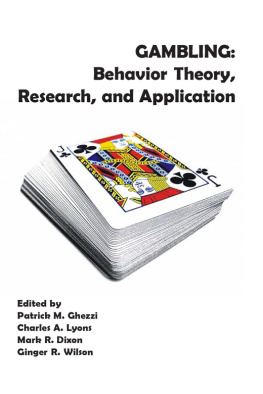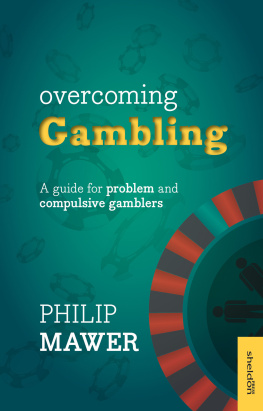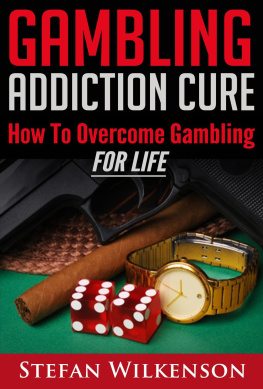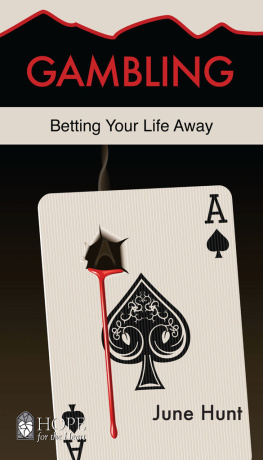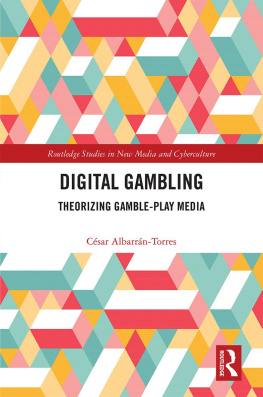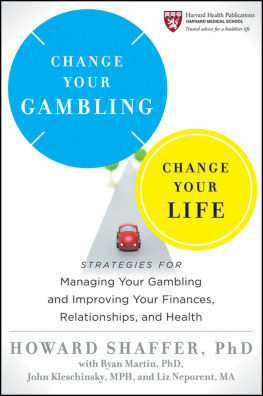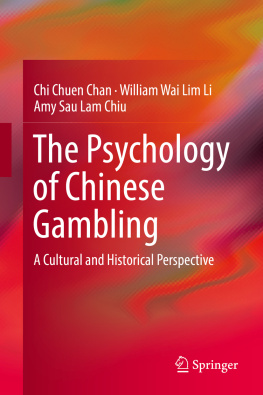Chapter 12
Cognitive-Behavioral Treatments for Pathological Gambling
Nancy M. Petry
University of Connecticut Health Center - Department of Psychiatry
John M. Roll
Washington State University
The similarities between gambling and behaviors maintained by intermittent schedules of reinforcement suggest a need to evaluate gambling in general, as well as in its most extreme sense of pathological gambling, from a behavioral standpoint. This chapter, adapted from Petry and Roll (2001), first reviews how behavioral principles can be applied to better understand the development and maintenance of gambling behaviors. Then, the literature on behavioral and cognitive-behavioral treatments for pathological gambling is reviewed.
Behavioral Account of Gambling
Several behavioral principles can be applied to the understanding of gambling behaviors. These include: intermittent schedules of reinforcement, magnitude of reinforcement, response cost, priming, modeling and second order conditioning, and immediacy of reward. These concepts are described as they relate to gambling.
Intermittent Schedules of Reinforcement
Intermittent schedules of reinforcement are widely investigated in terms of maintaining behaviors. The variable ratio schedule is one type of intermittent schedule. It refers to a schedule that provides a reinforcer after an average number of responses have been made (Ferster & Skinner, 1957). For example, on average every fifth peck on a key may result in a piece of food. These reinforcement schedules engender a response pattern that is characterized by very high response rates, with animals often responding at hundreds of responses per reinforcer. Behaviors shaped under variable ratio schedules of reinforcement can persist for a very long time, even after the reinforcer is removed (Ferster & Skinner, 1957).
Many forms of gambling appear to share some commonalities with variable ratio schedules of reinforcement. Slot machine gambling and scratch tickets, in particular, can be thought of as variable ratio schedules of reinforcement. That is, every 2-3 pulls on the slot machine and every 2-3 scratch tickets purchased result in a win, albeit usually a small magnitude one of just $1 or $2. These small but relatively frequent wins may engender behaviors of repeated slot machine playing or scratch ticket purchases in some individuals.
Another feature that gambling appears to share with variable schedules of reinforcement is related to superstitions. Skinner was the first to report superstitious behaviors in animals, and he noted that these behaviors arose in response to variable schedules of reinforcement (Skinner, 1948). By reinforcing a key peck every 2 minutes on average, a pigeon may have been turning to the right when a reinforcer was delivered. The pigeon may make a false connection between the behavior and the delivery of the reinforcer, and it may begin turning to the right every time it is placed in the operant chamber. This behavior occurs because of the random pairing between the behavior and the reinforcer, even though turning to the right in no way influences receipt of the food. Skinner demonstrated that superstitious behaviors are maintained long-term in pigeons, and gamblers similarly may also hold beliefs about their superstitions even in the face of repeated non-reinforcement.
Toneatto (1999) described several types of superstitions in gamblers. Behavioral superstitions refer to actions or rituals thought to enhance outcomes of gambling events. Examples include calling out for numbers when dice are rolled, shouting for ones horse, or clapping during the spin of a roulette wheel. Cognitive superstitions refer to the use of prayer, hope, or a strong conviction that a win is about to occur (King, 1990; Toneatto, Blitz-Miller, Calderwood, Dragonetti, & Tsanos, 1997). Talismanic superstitions relate to the belief that having certain objects or attributes will increase the chance of winning. For example, holding a lucky rabbits foot, wearing a green shirt, or seeing a specific number or letter combination on a license plate may be thought to signify that a win is near (King, 1990; Wagenaar, 1988). Bersabe and Arias (2000) studied this phenomenon in college students who were exposed to a gambling situation in which they won frequently while wearing a special watch, and lost frequently when not wearing the watch. They were later asked whether or not they wanted to wear the watch while gambling, and they chose to wear it. All these superstitions may have developed from random pairings. When winning, one may have worn a particular shirt or carried a charm. This random pairing may reinforce subsequent decisions to wear that shirt or carry the charm.
Magnitudes of Reinforcement
Another aspect of behavior theory that has relevance to gambling behaviors is reinforcement magnitude. Magnitudes of reinforcement affect the rate of learning and the strength of responding. Behaviors are learned rapidly when the amount of reinforcement obtained is large (Llewellyn, Iglauer, & Woods, 1976; Schneider, 1973). That is, rats will readily learn to press a lever to obtain a pellet of food, but if the amount of food is very small (e.g., a crumb) the rat may never learn to respond. Similarly, gamblers will not wager high bets if the maximal pay-out is low. When a jackpot exceeds $100 million, however, Powerball tickets are purchased in large quantities.
Most forms of gambling are associated with variable magnitudes of payoffs, such as the small but frequent earnings that are programmed in slot machines, and the $2 and $5 wins on scratch tickets. Behavioral research shows that laboratory animals prefer schedules that are associated with varying magnitudes or probabilities of reinforcement, rather than constant ones (Caraco, 1980; Sherman & Thomas, 1968). Likewise, humans tend to wager on events that have varying levels of payoffs. The unpopularity of jackpot only slot machines, a temporary and failed experiment in Las Vegas, may demonstrate this behavioral phenomenon among gamblers.
Response Cost
Response cost interacts with magnitude of reinforcement to influence behavior (Weiner, 1962). Response cost refers to the amount of effort necessary to obtain a reinforcer. In other words, a rat will rather quickly learn to press a lever to obtain food so long as the amount of force needed to register the lever press is minimal and the amount of food is sufficient. If the rat needs to exert its entire body weight to depress the lever, it may never press down on the lever sufficiently to earn the reinforcer. In this case, learning will occur much more slowly, if at all (Miller, 1970). Nevertheless, once the behavior has been established, the response cost can be increased, and the animal will continue responding, at least until a break point occurs.
Response cost appears to be important in gambling behaviors. Lottery and scratch tickets, as well as slot machines, are popular because the chance to win large amounts of money is available at a low response cost $1 or even $0.25. No one begins gambling on the $100 slot machines or initially places $1000 wagers on a card game. Instead, gambling begins with low-cost machines and the $10-$20 poker hands. Once a behavioral pattern of gambling is established, however, the response cost can be increased, and some individuals will maintain the behavior even at very high response costs. After gambling repeatedly at the $0.25 slots, one may move to the $1 machines, and then even the $5, $10 and $100 machines. This increase in wagering amounts is one of the Diagnostic and Statistical Manual for Mental Disorders (American Psychiatric Association, 1994) criteria for pathological gambling. It appears to be similar to the behavioral concept of tolerance.
Priming
Priming is a concept related to response cost. Priming refers to delivering a free reinforcer to re-establish a behavior pattern (Lynch & Carroll, 2000). An example is placing a food pellet in the hopper at the beginning of a session. A rat that has extinguished responding will readily respond again following the delivery of a prime. For gamblers, the small wins that occur in slot machines and scratch tickets, as well as the occasional win in card games, may serve as primers, further encouraging gambling behavior. In addition, the arrival in the mail of a coupon for a free meal at a casino restaurant, or a free night in the hotel to patrons who have not visited the casino in a while, may serve as a primer for them to return to gambling.

